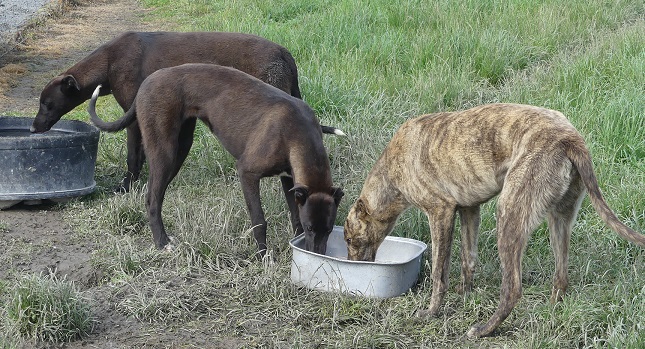Nutritional Basics for Racing Greyhounds
Nutritional Basics for Racing Greyhounds
This content was originally published in March 2019 On Track magazine and was sourced from a New South Wales, Australia training publication. For the full paper, which details additional nutritional facts and information, please click here.
If you are looking for an edge in your greyhounds’ racing performance, nutrition improvements can help provide optimum speed. Applying good nutritional principles optimises performance and health, and has a significant influence on the adaptation of the greyhound to the physical and metabolic stresses of racing. This article contains the basics of what you need to know to maintain the health of your racing greyhounds.
From Art to Science
There has been an increase of research into the science of feeding racing greyhounds since the sport began in New Zealand. What racing greyhound trainers used to feed their athletes was based on practices passed from experienced trainers to incoming ones. This ‘art’ has been finessed over the decades and now scientific research supplements most trainer’s practices. This movement from art to science is informing top greyhound trainers’ feeding regimes, and both are considered when determining what, how much and when to feed.
A well-balanced diet
The definition of a well balanced diet is: the supply of all essential nutrients, in the correct amount and proportions, to an animal. The six main nutrients are 1) Protein 2) Fats 3) Carbohydrates 4) Vitamins 5) Minerals and 6) Water. Each are required in a greyhound’s diet and contribute to a greyhound’s performance and health.
Protein is used for building and repairing muscles and various other body tissues. It is also used to form new skin cells, grow hair, build muscle tissue, etc. It also helps the body create necessary chemicals, like hormones and enzymes. Sources of protein include chicken, beef, lamb, fish, eggs, liver meat, soybean and barley, among others.
2. Fats
Fat is the most concentrated form of energy and yields three times as much energy per gram as compared to carbohydrates and protein. Fat is necessary for the absorption and transport of fat soluble vitamins. It contributes to the palatability of food and is used in the manufacture of cell membranes, controlling loss of water through the skin and keeping the coat shiny. Fat also aids in wound healing.
3. Carbohydrates
Many carbohydrates are not a normal constituent in the diet of a carnivore and are not an essential nutrient. They help with palatability and act as a cheap source of energy, but if fed to excess will be converted to fat and stored. Sugars are carbohydrates, as well as pasta, potatoes, rice and rice flour, wheat and gluten, corn and corn flour, peanut hulls and beet pulp.
4. Vitamins
Greyhounds, like any other animal, need vitamins to live and function properly.
Water soluble vitamins include B complex and C, are not stored in the body and require daily intake. In cases of prolonged water loss (excessive urination or diarrhoea), they may need supplementation. Water soluble vitamins include thiamine B1, riboflavin B2, niacin, vitamin B12 and folic acid.
Fat soluble vitamins are stored in the fatty tissues and liver and can reach toxic levels if fed in excess. Because they are stored, animals do not need a daily supply. Fat soluble vitamins include vitamins A, D, E and K.
5. Minerals
Minerals are inorganic chemicals that are required in small amounts to be incorporated into an animal’s body. Macro-minerals are minerals that are needed in small but not minute amounts e.g. calcium, phosphorous, sodium, potassium, magnesium, iron chlorine and sulphur. Micro-minerals (or trace minerals) are minerals that are required in minute amounts e.g. manganese, zinc, copper, molybdenum, fluorine, selenium, iodine and tin. Minerals must be balanced in the diet as excesses of one may prevent the uptake of others, causing a deficiency.
Additionally, the calcium:phosphorus ratio is crucial to get right. Meat contains a lot of phosphorus, so the more meat a diet contains, the more calcium will be required to reach the correct calcium:phosphorus ratio. Ground eggshells and bone shanks provide good amounts of calcium. The calcium:phosphorus ratio in the daily intake should be 1.1 - 1.4 to 1.
Another good source of calcium is DiCalcium Phosphate or DCP-chemically Ca3(PO4)2 with a calcium: phosphorus ratio of 1.5:1. Adult greyhounds being fed a high meat diet should receive 1 - 1 1/2 teaspoons of DCP daily mixed with their food.
6. Water
Water is the one most important nutrient required for life as the body is made up of 60 - 70% water. Water is found inside and outside cells, circulating and non-circulating, and because it is found all throughout the body, it is involved in practically every single body process.
Water is essential for thermoregulation (regulation of body temperature), lubrication of body tissues, as a fluid for blood and lymph to flow, maintaining normal electrolyte concentrations in body fluids, and digestion.
Greyhounds generally need 30 - 70mls of water per kg of bodyweight per day (more if they are suffering extra losses such as vomiting, diarrhoea, lactating, sweating, etc.
Water quality is not all the same. A good rule of thumb is: If you would not drink the water, do not expect the animal to either.



